Calculating Liner Size
When choosing liner size for a pond opening, two dimensions are needed:
- Length of Liner: Max length of opening + 2x Depth + 3'
- Width of Liner: Max width of opening + 2x Depth + 3'
Example: Pond Opening is 10' long, 8' wide and 2' deep
Length of liner: 10' + 4' (2' x 2') + 3' = 17
Width of liner: 8' + 4' (2' + 2') + 3' = 15
Liner should be a minimum of 15' x 17'
Estimating Energy Consumption
The following formula will allow you to compute the approximate energy cost of running a pump for 24 hours a day: Just insert the wattage and calculate.

Pump Facts
Horse Power: 1 HP = 746 Watts
Watts = Volts x Amps
Amps = Watts / Volts
P.S.I. = Max Head of Pump / 2.31
Max Head: Maximum height (in feet) that a pump can push water through the correct size of tubing.
Tubing Flow Rates
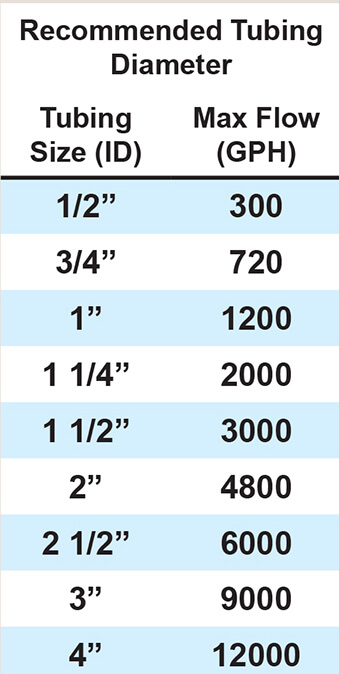 This chart shows maximum flow rates for common sized tubing. The chart is very helpful when selecting the correct tubing size for a project. If the tubing size chosen is too small, the flow of water from the pump will be restricted. This chart shows maximum flow rates for common sized tubing. The chart is very helpful when selecting the correct tubing size for a project. If the tubing size chosen is too small, the flow of water from the pump will be restricted.
Note: Tubing size is an inside diameter measurement.
(Flow Rates will vary between different charts – use as a reference)
Weir Flow Rates
Most streams and waterfalls start when water flows over a waterfall weir. To help calculate the desired flow of water over the weir, the following information is a useful guide for approximate flow rates.
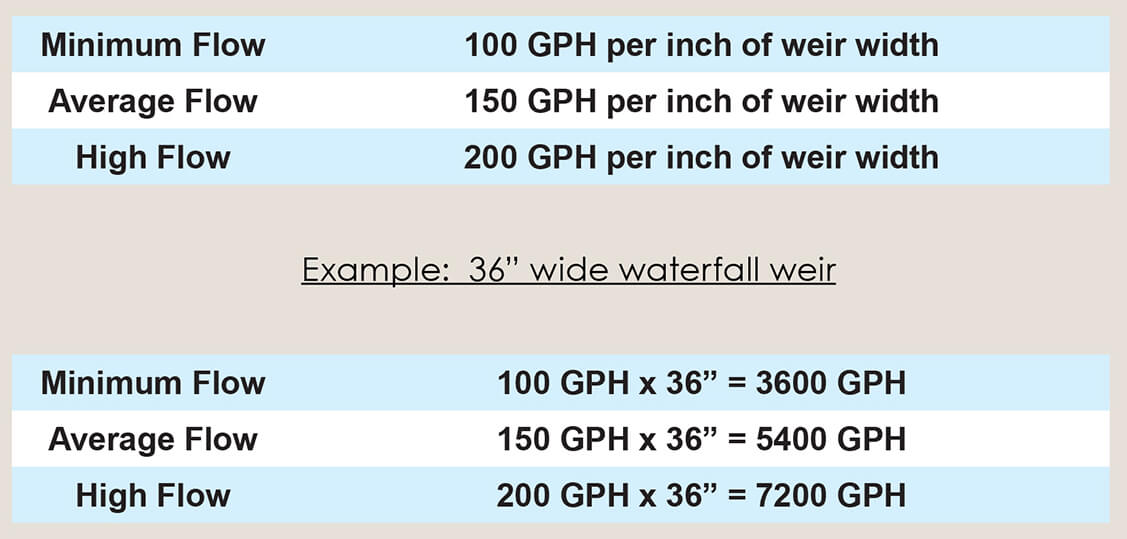
This information is invaluable when deciding what pump to use for a pond project.
Pumps
Choosing the correct pump size for a water garden project is extremely important. Following is an important factor to consider when reviewing pump choices.
A factor that affects a pump’s performance:
Head Height: The elevation that the water is being pumped to, determines the flow rate of the pump. The higher the elevation, the larger the reduction in the flow rate. All pumps have a maximum pumping height. The point at which a pump can no longer move water upward is called the max head. The example below represents this trait for all water pumps.
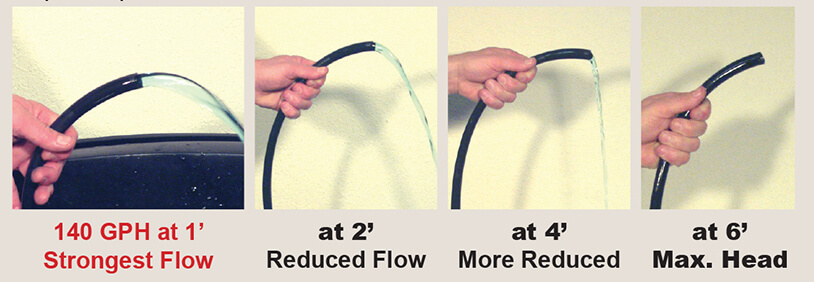
There is a point at which gravity will not allow water to be pumped any higher.
Water is heavy – a gallon of water weighs over 8 lbs.
Tubing
Another important factor that affects a pump’s performance:
Size of Tubing: The flow of water through tubing is always affected by friction. The smaller the inner diameter tubing, the more friction loss. In the experiment below, the same 700 GPH pump was run for 10 second intervals; the only difference was the size of the tubing. It became very obvious that choosing the wrong size tubing could very much affect pump performance. This effect on performance is true for any size or type of water pump.
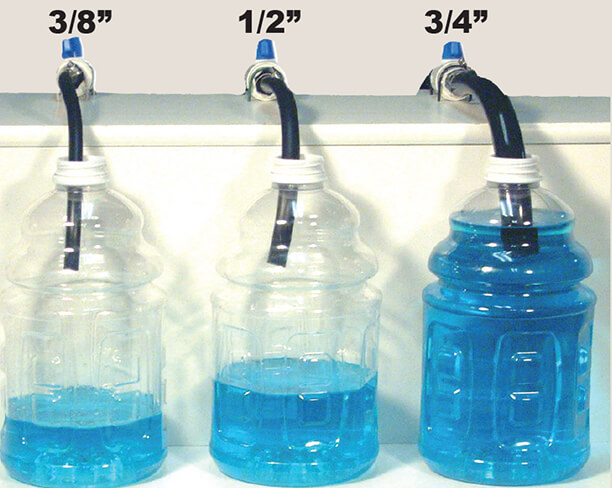
Algae in Ponds
In the most general terms, pond algae can be divided into two types: SINGLE CELL & STRING ALGAE.
|
SINGLE CELL ALGAE
Microscopic single cell algae causes pond water to turn a pea soup, green color. They will appear when nutrients, sunlight, and water are present. They are so small that it is not possible to simply “filter” them out of pond water.
|
STRING/FILAMENTOUS ALGAE
String algae often appears in clear pond water. It attaches itself to rock in streambeds and waterfalls. Also to sides of rocks inside pond. Blanketweed is another form of string algae. It rises to the surface of pond during heat of the day and sinks when water cools.
|
|
METHODS OF REMOVAL
- Flocculants
- UV Clarifiers
- Reduce food source
- Algaecide
- Beneficial bacteria & plants help by reducing nutrients needed for algae to survive
|
METHODS OF REMOVAL
- Products that break down organic debris
- Algaecide
- Brush/Twister
- Pond Vacuum
|
Nitrogen Cycle in Garden Ponds
Fish can take care of themselves, if pond-keepers take care of water!
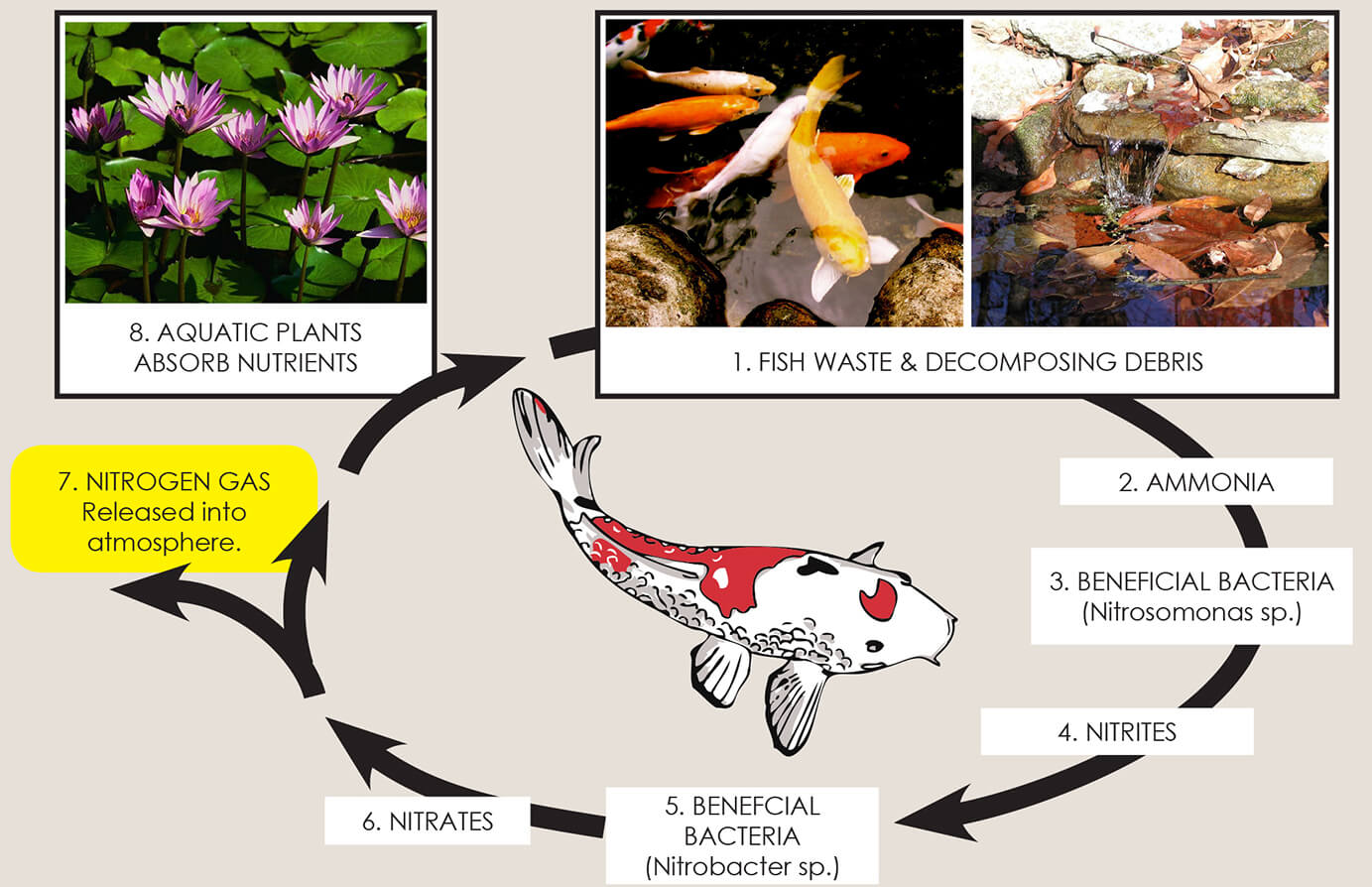
BAD WATER QUALITY (AMMONIA, NITRITES, & NITRATES)
Bad water quality through OVERSTOCKING, or IMPROPER FILTRATION creates opportunistic environments for disease/pathogens to take their toll on fish in a pond.
Pond Volume
Being able to calculate the volume of water in a pond is significant.
- Best Method: When filling the pond for the first time – use a water meter
- Method 2: Calculate the length of time needed to fill a 5 gallon container and calculate how long it takes to fill the pond – then compile results.
- Method 3 (most common method): Use the following formula to figure out how many cubic feet are in the ponds opening:
Average Length x Average Width x Average Depth x 7.48 = Gallons in Pond
(One cubic foot of water = 7.48 gallons)
Volume for Circular Pond
Radius x Radius x 3.14 x Depth = Cubic Feet
Cubic Feet x 7.48 = Gallons in Circular Pond
Pump Selection
When approximate pond volume is known, selecting a pump becomes easier. It is best to try to turn pond water over once every hour.
Example: 2500 gallon pond – The pump chosen should perform close to 2500 GPH after considering pumping height and tubing length (Total Dynamic Head – TDH).
Pump Performance Charts
Most pump manufacturers provide performance charts to show customers pump results at different pumping heights. See chart below.
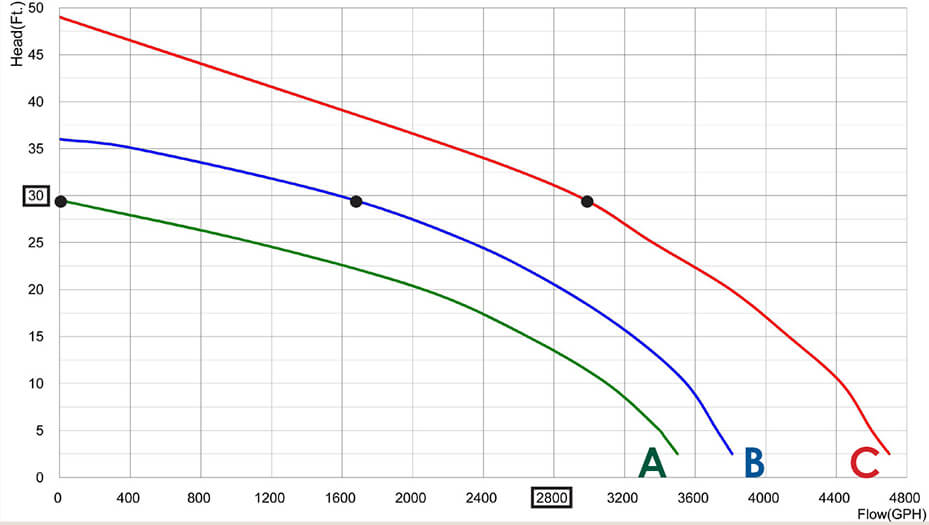
Example: Desired flow for project is approximately 2800 GPH at 30’ of TDH
Pump A produces: 0 GPH at 30’ of head
Pump B produces: 1600 GPH at 30’ of head
Pump C produces: 2800+ GPH at 30’ of head – Best choice for the project
|